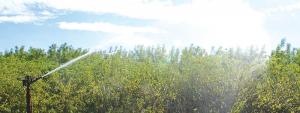2022 - Volume #46, Issue #2, Page #10
[ Sample Stories From This Issue | List of All Stories In This Issue | Print this story
| Read this issue]
Willow Plantations Help Reclaim Land
 |
But many abandoned sites were started too long ago and don’t have a soil stockpile for reclamation purposes.
Sylvis Environmental Services helps with these situations.
“Step one is finding an efficient and renewable way to essentially manufacture a topsoil or combine the materials required to form a topsoil starter,” says John Lavery, Sylvis senior scientist and business development manager. “We know it’s not a topsoil yet, just a growing medium.”
To begin, Sylvis contracts with cities, municipalities and mine landowners to collect biosolids, water treatment residuals, manure, compost, or pulp and paper sludge, all with a combination of nutrients and organic matter to address topsoil deficiencies. This material is then mixed, reconstituted and spread on the targeted land sites.
Sylvis then plants willow trees that take root and grow over a 30-year cycle. Willows are selected as they are extremely fast-growing, root to the proper depth and help accelerate soil formation without loss.
The willow plantations are harvested every 3 yrs. using agricultural-style machinery. The collected bio and fiber products become usable as renewable biomass, cellulosic ethanol fuel, or as a composting agent.
“The value in this type of reclamation restoration perspective is the below-ground processes aren’t being disturbed,” Lavery says. “They’re allowed to continue, so the natural processes of soil formation that require this biological rooting intervention are happening uninterrupted.”
After harvest, access to the soil is again available and more organic materials and fertilizer are added to the reconstituted topsoil to allow new willow regrowth at a highly productive rate.
Lavery explains when the woody biomass is harvested, most nutrients remain in the soil. After the 30-year cycle, a rich and productive agricultural land base will be handed over to cereal crops or other farming systems.
“The willow plantations also become an oasis for wildlife, birds and prairie biodiversity,” Lavery says. “Additionally, they pump carbon into the soil. We’re helping mitigate climate change with carbon sequestration along with the ‘top of ground’ resources harvested. Plus, we’re helping meet carbon footprint reduction goals by gaining carbon credits from the biosolids used on the land and from the soil root systems.”
Sylvis has ongoing willow projects in Alberta and consults with dozens of cities and municipalities in the U.S. and Canada.
“It’s a long-term soil building system and a great way to bring non-productive land back into production while generating some revenue with willows. The carbon sequestration and positive climate change impacts we achieve are almost unparalleled. Our willow projects have shown tremendous promise and incredible resilience.”
Contact: FARM SHOW Followup, John Lavery, Sylvis Environmental, 427 Seventh St., New Westminster, B.C., Canada V3M 3L2 (ph 800-778-1377; info@sylvis.com; www.sylvis.com).

Click here to download page story appeared in.

Click here to read entire issue
To read the rest of this story, download this issue below or click here to register with your account number.




